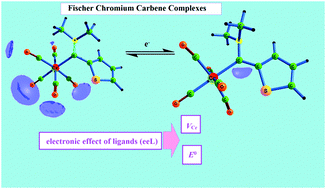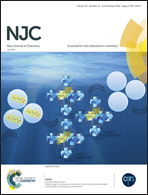Electronic effect of ligands vs. reduction potentials of Fischer carbene complexes of chromium: a molecular electrostatic potential analysis†
Abstract
Transition metal Fischer carbene complexes have ample applications in chemistry owing to their attractive redox properties which are highly sensitive to the electronic effect of ligands (eeL) and substituents. We present a systematic investigation of the reduction potentials (E0) of a large variety of Fischer carbene complexes (FCCs) of chromium using the B3LYP/Gen1//B3LYP/Gen1/SMD density functional theory. The change in eeL due to the electron donating/withdrawing substituent (R) and variations in the ligand environment is quantified using topographical features of the molecular electrostatic potential (MESP). In the reduced FCC, the carbene carbon showed the MESP minimum (Vmin) indicating significant localization of the extra electron on that ligand which supports the characteristic Mδ−![[double bond, length as m-dash]](https://www.rsc.org/images/entities/char_e001.gif) Cδ+ behaviour of the metal–carbon bond in the neutral FCC. The MESP at the chromium centre (VCr) showed a clear linear dependency on E0. The change in the reduction potential (ΔE0) due to variations in ligand environment is found to be directly proportional to change in the eeL measured as ΔVCr. This relationship is verified for experimentally known FCCs and is further extended to several unknown systems. Our results confirm the highly sensitive nature of the reduction potential of FCCs with respect to the eeL and remote substituent effects. The MESP at the metal center clearly emerged as a direct descriptor of eeL of FCCs which can be used to make predictions on the redox activities of the complexes.
Cδ+ behaviour of the metal–carbon bond in the neutral FCC. The MESP at the chromium centre (VCr) showed a clear linear dependency on E0. The change in the reduction potential (ΔE0) due to variations in ligand environment is found to be directly proportional to change in the eeL measured as ΔVCr. This relationship is verified for experimentally known FCCs and is further extended to several unknown systems. Our results confirm the highly sensitive nature of the reduction potential of FCCs with respect to the eeL and remote substituent effects. The MESP at the metal center clearly emerged as a direct descriptor of eeL of FCCs which can be used to make predictions on the redox activities of the complexes.



 Please wait while we load your content...
Please wait while we load your content...